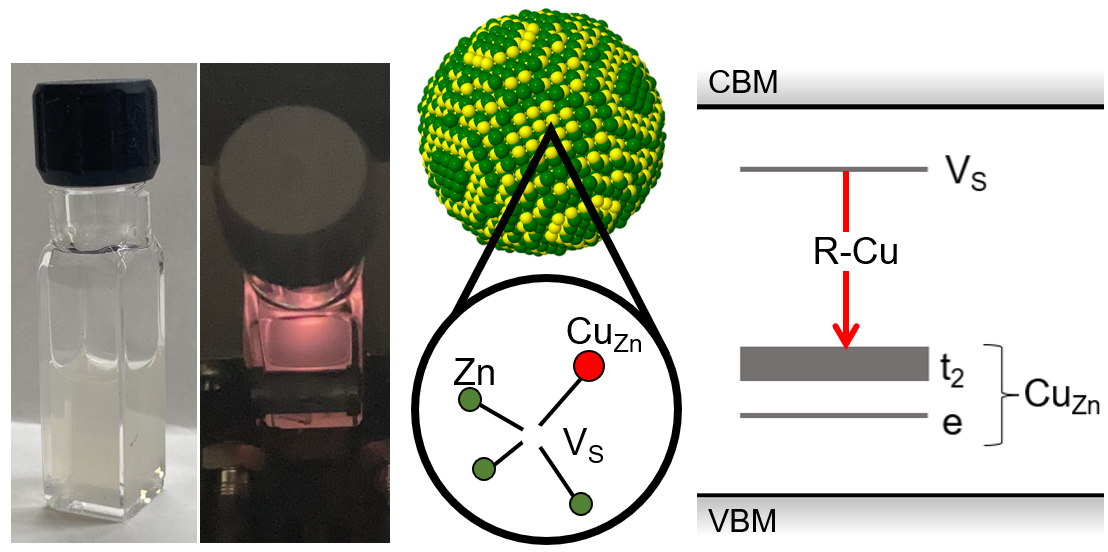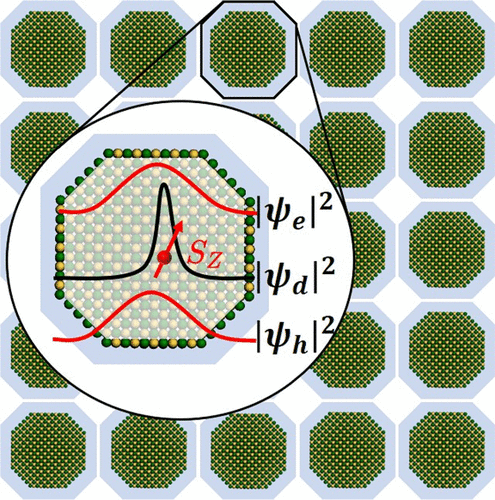
Sarah Thompson
Ph.D. Student, Electrical Engineering
Contact
200 S. 33rd St
310 Moore Building
Philadelphia, PA 19104
Email: satho@seas.upenn.edu
Phone: (215) 898-8312
Fax: (215) 573-2068
200 S. 33rd St
310 Moore Building
Philadelphia, PA 19104
Email: satho@seas.upenn.edu
Phone: (215) 898-8312
Fax: (215) 573-2068
Sarah received her B.S. in electrical engineering from Columbia University in 2018. Her undergraduate research focused on thin-film, organic optoelectronics for flexible sensing and solar energy harvesting. Her research interests include the design and fabrication of multifunctional nanomaterials for quantum control and energy applications. Sarah was awarded an NSF Graduate Research Fellowship in 2018.
 | Thompson, Sarah M; Şahin, Cüneyt; Yang, Shengsong; Flatté, Michael E; Murray, Christopher B; Bassett, Lee C; Kagan, Cherie R Red Emission from Copper-Vacancy Color Centers in Zinc Sulfide Colloidal Nanocrystals Journal Article ACS Nano, 2023. @article{Thompson2023, title = {Red Emission from Copper-Vacancy Color Centers in Zinc Sulfide Colloidal Nanocrystals}, author = {Sarah M. Thompson and Cüneyt Şahin and Shengsong Yang and Michael E. Flatté and Christopher B. Murray and Lee C. Bassett and Cherie R. Kagan}, url = {https://pubs.acs.org/doi/full/10.1021/acsnano.3c00191 https://arxiv.org/abs/2301.04223}, doi = {10.1021/acsnano.3c00191}, year = {2023}, date = {2023-03-09}, journal = {ACS Nano}, abstract = {Copper-doped zinc sulfide (ZnS:Cu) exhibits down-conversion luminescence in the UV, visible, and IR regions of the electromagnetic spectrum; the visible red, green, and blue emission is referred to as R-Cu, G-Cu, and B-Cu, respectively. The sub-bandgap emission arises from optical transitions between localized electronic states created by point defects, making ZnS:Cu a prolific phosphor material and an intriguing candidate material for quantum information science, where point defects excel as single-photon sources and spin qubits. Colloidal nanocrystals (NCs) of ZnS:Cu are particularly interesting as hosts for the creation, isolation, and measurement of quantum defects, since their size, composition, and surface chemistry can be precisely tailored for bio-sensing and opto-electronic applications. Here, we present a method for synthesizing colloidal ZnS:Cu NCs that emit primarily R-Cu, which has been proposed to arise from the CuZn-VS complex, an impurity-vacancy point defect structure analogous to well-known quantum defects in other materials that produce favorable optical and spin dynamics. First principles calculations confirm the thermodynamic stability and electronic structure of CuZn-VS. Temperature- and time-dependent optical properties of ZnS:Cu NCs show blueshifting luminescence and an anomalous plateau in the intensity dependence as temperature is increased from 19 K to 290 K, for which we propose an empirical dynamical model based on thermally-activated coupling between two manifolds of states inside the ZnS bandgap. Understanding of R-Cu emission dynamics, combined with a controlled synthesis method for obtaining R-Cu centers in colloidal NC hosts, will greatly facilitate the development of CuZn-VS and related complexes as quantum point defects in ZnS.}, keywords = {}, pubstate = {published}, tppubtype = {article} } Copper-doped zinc sulfide (ZnS:Cu) exhibits down-conversion luminescence in the UV, visible, and IR regions of the electromagnetic spectrum; the visible red, green, and blue emission is referred to as R-Cu, G-Cu, and B-Cu, respectively. The sub-bandgap emission arises from optical transitions between localized electronic states created by point defects, making ZnS:Cu a prolific phosphor material and an intriguing candidate material for quantum information science, where point defects excel as single-photon sources and spin qubits. Colloidal nanocrystals (NCs) of ZnS:Cu are particularly interesting as hosts for the creation, isolation, and measurement of quantum defects, since their size, composition, and surface chemistry can be precisely tailored for bio-sensing and opto-electronic applications. Here, we present a method for synthesizing colloidal ZnS:Cu NCs that emit primarily R-Cu, which has been proposed to arise from the CuZn-VS complex, an impurity-vacancy point defect structure analogous to well-known quantum defects in other materials that produce favorable optical and spin dynamics. First principles calculations confirm the thermodynamic stability and electronic structure of CuZn-VS. Temperature- and time-dependent optical properties of ZnS:Cu NCs show blueshifting luminescence and an anomalous plateau in the intensity dependence as temperature is increased from 19 K to 290 K, for which we propose an empirical dynamical model based on thermally-activated coupling between two manifolds of states inside the ZnS bandgap. Understanding of R-Cu emission dynamics, combined with a controlled synthesis method for obtaining R-Cu centers in colloidal NC hosts, will greatly facilitate the development of CuZn-VS and related complexes as quantum point defects in ZnS. |
 | Kagan, Cherie R; Bassett, Lee C; Murray, Christopher B; Thompson, Sarah M Colloidal Quantum Dots as Platforms for Quantum Information Science Journal Article Chemical Reviews, 2020. @article{Kagan2020, title = {Colloidal Quantum Dots as Platforms for Quantum Information Science}, author = {Cherie R. Kagan and Lee C. Bassett and Christopher B. Murray and Sarah M. Thompson}, url = {https://pubs.acs.org/doi/10.1021/acs.chemrev.0c00831}, doi = {10.1021/acs.chemrev.0c00831}, year = {2020}, date = {2020-12-29}, journal = {Chemical Reviews}, abstract = {Colloidal quantum dots (QDs) are nanoscale semiconductor crystals with surface ligands that enable their dispersion in solvents. Quantum confinement effects facilitate wave function engineering to sculpt the spatial distribution of charge and spin states and thus the energy and dynamics of QD optical transitions. Colloidal QDs can be integrated in devices using solution-based assembly methods to position single QDs and to create ordered QD arrays. Here, we describe the synthesis, assembly, and photophysical properties of colloidal QDs that have captured scientific imagination and have been harnessed in optical applications. We focus especially on the current understanding of their quantum coherent effects and opportunities to exploit QDs as platforms for quantum information science. Freedom in QD design to isolate and control the quantum mechanical properties of charge, spin, and light presents various approaches to create systems with robust, addressable quantum states. We consider the attributes of QDs for optically addressable qubits in emerging quantum computation, sensing, simulation, and communication technologies, e.g., as robust sources of indistinguishable, single photons that can be integrated into photonic structures to amplify, direct, and tune their emission or as hosts for isolated, coherent spin states that can be coupled to light or to other spins in QD arrays.}, keywords = {}, pubstate = {published}, tppubtype = {article} } Colloidal quantum dots (QDs) are nanoscale semiconductor crystals with surface ligands that enable their dispersion in solvents. Quantum confinement effects facilitate wave function engineering to sculpt the spatial distribution of charge and spin states and thus the energy and dynamics of QD optical transitions. Colloidal QDs can be integrated in devices using solution-based assembly methods to position single QDs and to create ordered QD arrays. Here, we describe the synthesis, assembly, and photophysical properties of colloidal QDs that have captured scientific imagination and have been harnessed in optical applications. We focus especially on the current understanding of their quantum coherent effects and opportunities to exploit QDs as platforms for quantum information science. Freedom in QD design to isolate and control the quantum mechanical properties of charge, spin, and light presents various approaches to create systems with robust, addressable quantum states. We consider the attributes of QDs for optically addressable qubits in emerging quantum computation, sensing, simulation, and communication technologies, e.g., as robust sources of indistinguishable, single photons that can be integrated into photonic structures to amplify, direct, and tune their emission or as hosts for isolated, coherent spin states that can be coupled to light or to other spins in QD arrays. |
